Featured Posts

- Index of Psychological Studies of Presidents and Other Leaders Conducted at the Unit for the Study of Personality in Politics
- The Personality Profile of U.S. Supreme Court Associate Justice Brett Kavanaugh
- The Leadership Style of North Korean Leader Kim Jong-un
- North Korea Threat Assessment: The Psychological Profile of Kim Jong-un
- Russia Threat Assessment: Psychological Profile of Vladimir Putin
- The Personality Profile of 2016 Republican Presidential Candidate Donald Trump
- Donald Trump's Narcissism Is Not the Main Issue
- New Website on the Psychology of Politics
- Unit for the Study of Personality in Politics --- 'Media Tipsheet'
categories

- Afghanistan (228)
- Al Gore (2)
- Amy Klobuchar (4)
- Ayman al-Zawahiri (7)
- Barack Obama (60)
- Ben Carson (2)
- Bernie Sanders (7)
- Beto O'Rourke (3)
- Bill Clinton (4)
- Bob Dole (2)
- Campaign log (109)
- Chris Christie (2)
- Chuck Hagel (7)
- Criminal profiles (8)
- Dick Cheney (11)
- Domestic resistance movements (21)
- Donald Trump (31)
- Economy (33)
- Elizabeth Warren (4)
- Environment (24)
- George H. W. Bush (1)
- George W. Bush (21)
- Hillary Clinton (9)
- Immigration (39)
- Iran (43)
- Iraq (258)
- Jeb Bush (3)
- Joe Biden (13)
- John Edwards (2)
- John Kasich (2)
- John Kerry (1)
- John McCain (7)
- Kamala Harris (5)
- Kim Jong-il (3)
- Kim Jong-un (11)
- Law enforcement (25)
- Libya (18)
- Mahmoud Ahmadinejad (6)
- Marco Rubio (2)
- Michael Bloomberg (1)
- Michele Bachmann (173)
- Mike Pence (3)
- Military casualties (234)
- Missing person cases (37)
- Mitt Romney (13)
- Muqtada al-Sadr (10)
- Muslim Brotherhood (6)
- National security (16)
- Nelson Mandela (4)
- News (5)
- North Korea (36)
- Osama bin Laden (19)
- Pakistan (49)
- Personal log (25)
- Pete Buttigieg (4)
- Presidential candidates (19)
- Religious persecution (11)
- Rick Perry (3)
- Rick Santorum (2)
- Robert Mugabe (2)
- Rudy Giuliani (4)
- Russia (7)
- Sarah Palin (7)
- Scott Walker (2)
- Somalia (20)
- Supreme Court (4)
- Syria (5)
- Ted Cruz (4)
- Terrorism (65)
- Tim Pawlenty (8)
- Tom Horner (14)
- Tributes (40)
- Uncategorized (50)
- Vladimir Putin (4)
- Xi Jinping (2)
- Yemen (24)
Links

archives

- November 2021
- January 2021
- November 2020
- October 2020
- September 2020
- August 2020
- July 2020
- April 2020
- March 2020
- February 2020
- January 2020
- December 2019
- October 2019
- July 2019
- May 2019
- April 2019
- March 2019
- February 2019
- January 2019
- December 2018
- September 2018
- August 2018
- July 2018
- June 2018
- April 2018
- March 2018
- February 2018
- January 2018
- August 2017
- July 2017
- June 2017
- May 2017
- April 2017
- February 2017
- January 2017
- December 2016
- November 2016
- October 2016
- September 2016
- August 2016
- July 2016
- June 2016
- May 2016
- April 2016
- March 2016
- February 2016
- January 2016
- December 2015
- November 2015
- October 2015
- September 2015
- August 2015
- July 2015
- June 2015
- May 2015
- April 2015
- March 2015
- February 2015
- January 2015
- December 2014
- November 2014
- October 2014
- September 2014
- August 2014
- July 2014
- June 2014
- May 2014
- April 2014
- March 2014
- February 2014
- January 2014
- December 2013
- November 2013
- October 2013
- September 2013
- August 2013
- July 2013
- June 2013
- May 2013
- April 2013
- March 2013
- February 2013
- January 2013
- December 2012
- November 2012
- October 2012
- September 2012
- August 2012
- July 2012
- June 2012
- May 2012
- April 2012
- March 2012
- February 2012
- January 2012
- December 2011
- November 2011
- October 2011
- September 2011
- August 2011
- July 2011
- June 2011
- May 2011
- April 2011
- March 2011
- February 2011
- January 2011
- December 2010
- November 2010
- October 2010
- September 2010
- August 2010
- July 2010
- June 2010
- May 2010
- April 2010
- March 2010
- February 2010
- January 2010
- December 2009
- November 2009
- October 2009
- September 2009
- August 2009
- July 2009
- June 2009
- May 2009
- April 2009
- March 2009
- February 2009
- January 2009
- December 2008
- November 2008
- October 2008
- September 2008
- August 2008
- July 2008
meta

 On March 2, the New York Times reported that Hillary Rodham Clinton did not have a government email account while secretary of state and may have violated federal rules that officials’ correspondence be retained. (“Hillary Clinton used personal email account at State Dept.” by Michael S. Schmidt, New York Times, p. A1, March 3, 2015.)
On March 2, the New York Times reported that Hillary Rodham Clinton did not have a government email account while secretary of state and may have violated federal rules that officials’ correspondence be retained. (“Hillary Clinton used personal email account at State Dept.” by Michael S. Schmidt, New York Times, p. A1, March 3, 2015.)
The Washington Post has compiled an extensive timeline concerning government rules and regulations on the use of private email accounts and Clinton’s actions regarding her private account for the purpose of government communications. (“Hillary Clinton’s e-mails: A timeline of actions and regulations” by Glenn Kessler, Washington Post, March 10, 2015.)
Hillary Clinton statement on use of private email account. Watch complete presser
Following is a collection of research reports and related political analysis, conducted between 1999 and 2008, that may have a bearing on the matter in terms of Hillary Clinton’s personality traits, psychological motives, and leadership style.
October 2016 update: Hillary Clinton’s predominant personality patterns are Ambitious/self-serving (a measure of narcissism) and Dominant/controlling, infused with secondary features of the Conscientious/dutiful and Retiring/reserved (introverted) patterns and some indication of Distrusting/suspicious features. This particular personality composite can be labeled elitist narcissism or, in political terms, deliberative high-dominance introvert — deliberative by virtue of substantial conscientiousness.
[http://digitalcommons.csbsju.edu/psychology_pubs/102/]
The Personality Profile of 2008 Democratic Presidential Contender Hillary Clinton
Aubrey Immelman and Julie Seifert
Unit for the Study of Personality in Politics
December 2007
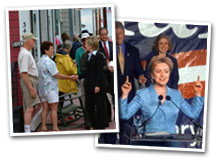
This research report presents the results of an analysis of the personality of New York senator Hillary Clinton, contender for the Democratic Party nomination in the 2008 U.S. presidential election, from the conceptual perspective of personologist Theodore Millon. Information concerning Sen. Clinton was collected from biographical sources and media reports and synthesized into a personality profile using the second edition of the Millon Inventory of Diagnostic Criteria (MIDC), which yields 34 normal and maladaptive personality classifications congruent with Axis II of DSM–IV.
The personality profile yielded by the MIDC was analyzed on the basis of interpretive guidelines provided in the MIDC and Millon Index of Personality Styles manuals. Clinton’s primary personality patterns were found to be Ambitious/self-serving and Dominant/controlling, with secondary Conscientious/dutiful features and subsidiary, more situation-specific, Contentious/resolute and Distrusting traits.
Ambitious individuals are bold, competitive, and self-assured; they easily assume leadership roles, expect others to recognize their special qualities, and often act as though entitled. Dominant individuals enjoy the power to direct others and to evoke obedience and respect; they are tough and unsentimental and often make effective leaders.
Hillary Clinton’s major personality strengths in a leadership role are her commanding presence and confident assertiveness. Her major personality-based shortcomings are an uncompromising, overcontrolling tendency, a lack of empathy and congeniality, and cognitive inflexibility.
The major implication of the study is that it offers an empirically based personological framework for anticipating Sen. Clinton’s likely leadership style as chief executive, thus providing a basis for inferring the character and tenor of a prospective Hillary Clinton presidency.
In terms of Lloyd Etheredge’s (1978) fourfold typology of personality-based foreign policy role orientations, which locates policymakers on the dimensions of dominance–submission and introversion–extraversion, Clinton’s profile most closely approximates the “high-dominance introvert†category. According to Etheredge, high-dominance introverts (e.g., presidents such as Woodrow Wilson and Herbert Hoover) are quite willing to use military force, tending
to divide the world, in their thought, between the moral values they think it ought to exhibit and the forces opposed to this vision. They tend to have a strong, almost Manichean, moral component to their views. They tend to be described as stubborn and tenacious. They seek to reshape the world in accordance with their personal vision, and their foreign policies are often characterized by the tenaciousness with which they advance one central idea. … [These leaders] seem relatively preoccupied with themes of exclusion, the establishment of institutions or principles to keep potentially disruptive forces in check. (p. 449; italics in original)
Etheredge’s high-dominance introvert is similar in character to Margaret Hermann’s (1987) expansionist orientation to foreign affairs. These leaders have a view of the world as being “divided into ‘us’ and ‘them,’ †based on a belief system in which conflict is viewed as inherent in the international system. This world view prompts a personal political style characterized by a “wariness of others’ motives†and a directive, controlling interpersonal orientation, resulting in a foreign policy “focused on issues of security and status,†favoring “low-commitment actions†and espousing “short-term, immediate change in the international arena.†Expansionist leaders “are not averse to using the ‘enemy’ as a scapegoat†and their rhetoric often may be “hostile in tone†(pp. 168–169).
Addendum: Hillary Clinton’s MIDC Scale Scores
References
Etheredge, L. S. (1978). Personality effects on American foreign policy, 1898–1968: A test of interpersonal generalization theory. American Political Science Review, 72, 434–451.
Hermann, M. G. (1987). Assessing the foreign policy role orientations of sub-Saharan African leaders. In S. G. Walker (Ed.), Role theory and foreign policy analysis (pp. 161–198). Durham, NC: Duke University Press.
Related report: April 2008 study

Click on image for larger view
Update: Detailed Psychological Assessments Released (Nov. 4, 2016)
The Unit for the Study of Personality in Politics has released political-psychological assessments of Hillary Clinton and Donald Trump.
Executive Summary: Hillary Clinton
Full text (34 pages)
The Political Personality of 2016 Democratic Presidential Nominee Hillary Clinton (Working paper, Unit for the Study of Personality in Politics, St. John’s University/College of St. Benedict, October 2016)
Executive Summary: Donald J. Trump
Full text (31 pages)
The Political Personality of 2016 Republican Presidential Nominee Donald J. Trump (Working paper, Unit for the Study of Personality in Politics, St. John’s University/College of St. Benedict, October 2016)
Comparison of Hillary Clinton’s and Donald Trump’s Profiles
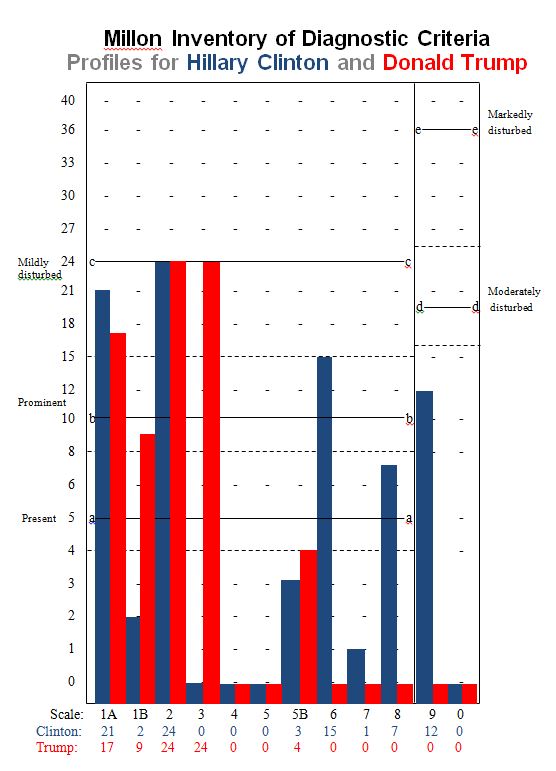
‘Monster’? The Darker Side of Hillary Clinton’s Character

Samantha Power (left), President Barack Obama, and then-Secretary of State Hillary Clinton sit together during a memorial service for diplomat Richard Holbrooke on Jan. 14, 2011, in Washington. (Photo: AP)
By Sarah Moore and Aubrey Immelman
Unit for the Study of Personality in Politics
March 8, 2008
Last Friday, Samantha Power, a foreign policy adviser to Barack Obama, made headlines by declaring Hillary Clinton “a monster.†In an article in a Scottish newspaper, Power was quoted as saying, “She is a monster, too — that is off the record — she is stooping to anything†(“‘Hillary Clinton’s a monster’: Obama aide blurts out attack in Scotsman interview,†The Scotsman, March 7, 2008).
Power resigned within hours of her gaffe hitting the headlines. “I made inexcusable remarks that are at marked variance from my oft-stated admiration for Senator Clinton and from the spirit, tenor, and purpose of the Obama campaign,†she wrote in a prepared statement.
Clearly, the ad hominem nature of Power’s personal attack was tasteless. However, should the substance of her tactless statement be brushed off summarily, or does it have a grain of truth that warrants closer examination in the public interest?
The present analysis is part of a series of nearly 30 analyses of political candidates — four of them dealing with Hillary Clinton — published in the Times since the 2000 election cycle by research collaborators at the Unit for the Study of Personality in Politics at the College of St. Benedict and St. John’s University.
Darker qualities
As noted in two recent articles in the series (“Does Clinton have only 1 card to play?†Feb. 26, 2008; “Clinton, Obama show their strengths,†Mar. 4, 2008), Clinton possesses qualities that could make her an effective leader. However, she also has personality traits (not highlighted in previous reports) that reveal a darker, Machiavellian side.
Three studies of Clinton conducted at the research unit in the past decade have identified, with consistent results, the core features of her personality.
Clinton’s profile contains a cluster of three prominent patterns: a dominant, controlling tendency (aggressiveness); an ambitious, self-serving tendency (narcissism); and a conscientious, dutiful tendency (obsessiveness).
Also of note, Clinton’s profile shows quite a high level of distrust and a relative lack of outgoing and accommodating features, suggesting a deficit of warmth and congeniality.
For more insight into Clinton’s character, let’s take a closer look at the three core qualities of her personality.
Dominant and controlling
Dominant individuals are tough, unsentimental, strong-willed, assertive, and outspoken. These qualities have many positive aspects; for example, speaking out and standing up for what you believe in, easily rising to leadership challenges, holding your ground, and demonstrating unflinching courage in the face of opposition.
However, these traits potentially have a more sinister side; the dominant tendency also reflects a strong drive for power and the expectation that their authority should be unquestioned. In addition to being coercive, these personalities tend to be unempathic, stubborn, and inflexible.
When pushed on personal matters, highly dominant leaders are prone to respond vindictively, especially when feeling humiliated or belittled. They are quick to attack when provoked or challenged and their first inclination is to dominate and demean their adversary.
Clinton has been portrayed as a no-nonsense individual who likes to take charge, is not easily intimidated, and often inspires respect — even grudging respect inspired by fear.
In his book The Choice (1996), Bob Woodward wrote that Clinton occasionally “snapped at people, even blew up, providing a momentary glimpse of inner rage. She seemed angry … [and] often seemed not to recognize when she was hurting people.â€
Woodward’s observation offers a glimpse of someone who needs to be in charge, does not easily tolerate dissent, and lacks empathy for others.
Ambitious and self-serving
In moderation, personal ambition also has positive aspects; for example, boldness, competitiveness, and self-assurance. But the self-confidence of ambitious leaders readily shades into arrogance, a sense of entitlement, and an air of superiority — and they often act as though entitled.
After interviewing many of Clinton’s associates for a 1994 article in New Yorker magazine, Connie Bruck concluded, “In the end, the sureness about her own judgment — at its extreme, a sense that she alone is wise — is probably Hillary’s cardinal trait.â€
Similarly, political scientist and psychoanalyst Stanley Renshon wrote in High Hopes: The Clinton Presidency and the Politics of Ambition that one aspect of Hillary Clinton’s character that stands out is her confidence in herself, her positions, and her work — resulting in a sense of entitlement, “a tendency to not want to be bound by limits that apply to others.â€
A distrusting nature
Clinton’s elevation on the “Distrusting†scale of the personality inventory used at the Unit for the Study of Personality in Politics to evaluate political leaders is unusually high relative to other candidates studied in the last four presidential election cycles.
Distrusting leaders — especially those who also happen to be highly dominant and ambitious — tend to be thin-skinned and hypersensitive to perceived slights; vengeful, with a willingness to “balance the books†with respect to perceived past wrongs; prone to “us versus them†thinking; self-righteous, acting arrogantly and with a sense of entitlement; and self-justifying, viewing their attacks on adversaries either as defensive necessity or as “payback.â€
For example, Clinton was reportedly the central figure in the 1993 White House travel office dismissals, in which scores were ruthlessly settled.
Gail Sheehy, in her book Hillary’s Choice (1999), had this to say about Clinton’s view of the world: “Her view of humanity is that mankind was born selfish and unruly and must be channeled. … Politics was the means. She even admitted that she couldn’t identify with the ‘faceless masses.’ She sounded … elitist, privileged, distrustful of the people.â€
So, Clinton may have a Hobbesian, dog-eat-dog view of the world, but that doesn’t justify the gratuitous demonization of pejoratively branding her “a monster.â€
That said, last December, former president Bill Clinton warned that to elect Obama would be “to ‘roll the dice’ for America.†By the same token, as we contemplate the prospect of the second Clinton presidency in a generation, it behooves Americans to ask themselves if they are willing to take a gamble on another Clinton.
Note. A slightly edited version of this article was published as the “Your Turn†column “‘Monster’? Consider darker side of Hillary Clinton†in the St. Cloud Times (p. 5B), March 12, 2008.
Comparing Clinton and Obama, Head-to-Head
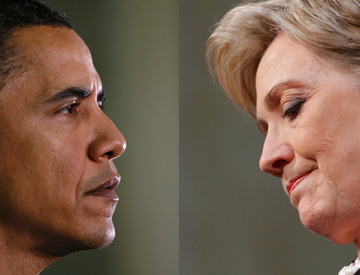
By Catherine London and Aubrey Immelman
Unit for the Study of Personality in Politics
March 3, 2008
As voters head for the polls in Tuesday’s critical big-state primaries in Ohio and Texas, presidential candidates Hillary Clinton and Barack Obama face what may be the day of decision in their bid for the Democratic nomination.
With 11 straight primary victories since Super Tuesday at his back, Obama has emerged as the frontrunner and a force to be reckoned with. For Clinton, tomorrow’s contests could be her final opportunity to reclaim the lead.
As the primary season lumbers on to an eventual nomination, the focus begins to shift from the horse race to the pointed question of what kind of leader a candidate will likely become. An important part of the answer can be found in personality: enduring personal traits that remain relatively constant over time and drive a person’s behavior across a broad range of situations, including, in this case, the seat behind the desk in the Oval Office.
Clinton, Obama head-to-head
To gain a better understanding of Clinton and Obama, we generated personality profiles using a standard assessment procedure developed at the Unit for the Study of Personality in Politics at the College of St. Benedict and St. John’s University.
The profile revealed that Clinton has a highly ambitious and somewhat self-serving, dominant and controlling, conscientious, dutiful personality.
Highly ambitious personalities have supreme self-confidence, though this tendency may sometimes shade into overconfidence and a sense of entitlement. Nonetheless, these individuals often make effective leaders, due to their bold, competitive nature.
Dominant personalities are strong-willed, commanding, and assertive. Although this is typically regarded as a leadership strength, a potential problem for Clinton is that for some voters these traits may feed into negative stereotypes of women, contributing to her high negatives in the polls.
Conscientious personalities are highly organized, diligent, and attentive to detail; however, they can also be rigid thinkers who find it difficult to make a mid-course correction when a well-made plan falters in its execution. By the same token, as candidates they may seem excessively programmed, which undermines their efforts to inspire voters.
The profile revealed that Obama, like Clinton, is ambitious and dominant, though not to the same degree. On a personal level, the primary distinction between Obama and Clinton is that where Clinton is conscientious, Obama is outgoing and congenial, which makes it easier for him to inspire followers and connect with people.
In a recent Los Angeles Times article (“Senate careers branch differently for Clinton, Obama,†Feb. 26, 2008) Janet Hooks examined differences between Clinton and Obama “that could ultimately make them very different presidents.â€
With similar intent, the Unit for the Study of Personality in Politics, in collaboration with McGill University political scientist Blema Steinberg, developed a model that maps out the links between personality and leadership style.
Why they run
Leaders with a personality pattern such as Clinton’s — dominant, ambitious, and conscientious — are primarily motivated by issues of power and to a lesser degree by ideology.
They are highly assertive and extremely confident, with a strong belief in their personal talents and leadership ability, as evident in Clinton’s remark last August at an AFL-CIO forum in Chicago: “If you want a winner that knows how to take them on, I’m your girl.â€
These leaders also exhibit a controlling, perfectionistic orientation — an aversion to leaving anything to chance. As LA Times reporter Hooks noted in her article, Clinton “chose to build a reputation as a skilled insider†who “mastered the levers of Senate power,†and “surprised her colleagues with her diligence.â€
Leaders with a personality pattern such as Obama’s — ambitious and outgoing — are primarily concerned with issues of self-validation. Despite their strong belief in themselves, they enlist pragmatism as a strategy for ensuring their own success and political ambition.
As Obama supporter and former Illinois state representative Paul L. Williams told the New York Times last July: Obama “came with a huge dose of practicality.†This quality comes into play, Hooks notes, in terms of “Obama’s focus on broad themes and overarching issues.â€
Measuring up to the job
Successful executive leadership requires the officeholder to strike a balance between goal-directed policy achievement and process-oriented organizational survival.
Clinton’s personality pattern suggests that as president she would be more goal directed, with a strong interest in solving policy problems effectively and accomplishing ideological objectives, and less interested in maintaining good relations among colleagues.
Obama’s personality pattern suggests that as president he also would be goal-directed, but that this tendency will be tempered by his outgoing orientation, leading him to place a higher premium than Clinton on process-oriented relationship maintenance, even if it comes at the expense of achieving short-term policy objectives.
That attribute served Obama well as a senator who skillfully maneuvered his way around Washington, forging friendships with politicians across party lines. In the process, he cemented a reputation for seeking consensus and being receptive to the views of those around him, regardless of political persuasion.
Handling people and the press
In the information age, mass media play a key role in national politics. Despite coming under fire as an idealistic, naïve candidate, “heavy on rhetoric and light on policy,†it’s hard for the media to ignore Obama’s rousing speeches and captivating rhetorical style. From his first moments in the national spotlight at the 2004 Democratic National Convention, Obama appeared polished and articulate, projecting the trademark charisma since showcased behind podiums across the country.
Sen. Clinton has been notably less successful in this regard, due in part to a strong drive to control the image projected by the media. In short, highly dominant leaders like Clinton tend to be less cooperative and accessible to the media, and therefore less likely to enjoy harmonious media relations.
A critical ingredient of successful executive leadership is the president’s skill in implementing policy decisions. In that regard, presidential personality is key.
Clinton, as a strong-willed, confident personality, can be expected to articulate and defend her policies personally rather than relying on others. The equally confident Obama will be similarly inclined.
There may, however, be a slight distinction in the sense that the more outgoing Obama would probably show a stronger preference for directly engaging the public, whereas the more conscientious, less extraverted Clinton would be less likely to enjoy this aspect of governing and therefore give senior administration officials a larger role in articulating and defending her policies.
Given these important distinctions between the two candidates in personality and leadership style, the question for primary voters tomorrow — who could in effect pick the Democratic nominee and likely next president of the United States — may be as simple as this: With whom would I rather share my living room for the next four years?
Note. A slightly edited version of this article was published as the “Your Turn†column “Clinton, Obama show their strengths: Personalities reveal how they may govern†in the St. Cloud Times (pp. 4-5B), March 4, 2008.
“Clinton’s Last Stand†— Does Hillary Have the Right Stuff to Triumph in Texas?

Sen. Hillary Clinton campaigns in Dallas on March 1, 2008 ahead of the Texas primary. (Photo: Justin Sullivan / Getty Images)
By Anna Phelps and Aubrey Immelman
Unit for the Study of Personality in Politics
February 25, 2008
The morning after last Tuesday’s crucial Wisconsin Democratic primary contest, the Associated Press led as follows: “Barack Obama cruised past a fading Hillary Rodham Clinton in the Wisconsin primary Tuesday night, gaining the upper hand in a Democratic presidential race for the ages.â€
But Saturday, at a Clinton campaign rally in Corpus Christi, former President Bill Clinton threw down the gauntlet in Texas. “Texas is going to decide this. If [Hillary] wins in Texas and she wins in Ohio, she will win in Pennsylvania and she will go on and win the nomination and be the president of the United States.â€
Tonight’s MSNBC debate in Cleveland offers Hillary Clinton her last best chance to show voters she has the right stuff to stop the advance of front-runner Barack Obama in next Tuesday’s make-or-break, rich-in-delegates primary contests in Texas and Ohio.
But, as the Los Angeles Times reported last week (“Clinton camp splits on message,†Feb. 21, 2008), the beleaguered Clinton campaign is at odds on how best to fend off Obama’s surge:
“As Hillary Clinton tries to revive her floundering campaign after losing 10 straight primary contests to Sen. Barack Obama, her strategists are divided on how to frame her image. Some want to emphasize her strength and experience while others think she should showcase her warmth and empathy. Yet others want to focus on the historic significance of electing the first woman president.â€
Framing an image
Despite a staff of 700, and $100 million in campaign expenditure, Clinton evidently has not invested in the counsel of a political psychology consultant. If she had, her advice likely would have been that the way to victory is authenticity, best achieved by cultivating a public persona consonant with her actual character.
For insight into Clinton’s character — deeply ingrained personality traits and attributes that are not easily altered and that remain relatively consistent over time — we consulted three personality profiles independently constructed by different researchers in the past decade at the Unit for the Study of Personality in Politics at the College of St. Benedict and St. John’s University.
The first study, conducted in 1998 by Jennifer Jo Hagel, “established that Clinton’s personality had a primarily dominant, controlling pattern with distinctly ambitious, highly confident features … [and] strong, though secondary, conscientious qualities.â€
A follow-up study, conducted by Avà Bahadoor in 2000, found that Clinton, in addition to being “highly organized, persistent, and conscientious,†was “a primarily dominant, controlling individual with highly ambitious, narcissistic qualities … that account for substantial self-confidence but readily shade into arrogance, a sense of entitlement, and an air of superiority.â€
Finally, in 2004, Elizabeth Malaktaris found Clinton’s personality pattern to be highly ambitious (self-serving), dominant (controlling), and conscientious (dutiful).
Framing an authentic image for Clinton that is consistent with her true character can best be achieved by showcasing her strength and experience, which is built on the foundation of her inherent dominance and conscientiousness.
High dominance makes Clinton a natural for rising to leadership challenges, rarely backing away from a fight. Her conscientiousness makes her the quintessential policy wonk, a competent manager with an eagle eye for the tiniest detail.
Hillary’s dilemma
The irony is that the strength-and-experience message, which carried Clinton through 2007 when her nomination seemed all but inevitable, began to unravel when the campaign entered its up-close-and-personal phase with the start of the primary season.
It began to founder when challenged by the force of personality of an unlikely opponent that on paper offered little match for Clinton’s dominance, experience, and policy acumen.
Clinton’s dilemma is that even though she surpasses Obama on ambition-driven confidence — the key ingredient of political charisma — she lacks the catalyst that creates the chemistry necessary to connect with people: an outgoing tendency that conveys personal warmth and likability.
Barack Obama has it, Hillary Clinton doesn’t; Bill Clinton has it, Bob Dole doesn’t; George W. Bush has it, Al Gore doesn’t — and neither does John Kerry. John McCain has it, and so does Mike Huckabee; Mitt Romney doesn’t have it either, and neither does Fred Thompson.
Can’t fake it
You can’t fake sincerity, at least not for long. For Clinton, the naked truth is that Plan B, to showcase her supposed warmth and empathy as some of her strategists would have her do, is simply a nonstarter — or at best a hard sell, because it’s entirely at variance with the core components of her personality.
While some observers may have perceived Clinton’s famous show of emotion the day before last month’s New Hampshire primary as a glimpse of “the real Hillary,†of genuine warmth and empathy buried deep beneath her tough exterior, realistically what we saw was more likely a momentary peek behind the veil of her persona, briefly laying bare the wounded ego of shaken confidence as she saw her personal dreams of glory slipping away in the snow of New Hampshire.
So, short of flaunting her toughness and going on the offensive, what remains for Clinton is to continue highlighting the historic significance of electing the first woman president of the United States.
But that’s hardly a good hand if it’s the only card Hillary has left to play.
Note. A slightly edited version of this article was published as the “Your Turn†column “Does Clinton have only 1 card to play†in the St. Cloud Times (pp. 7B), Feb. 26, 2008.
The Character of Hillary Rodham Clinton

Cover of the May 30, 1994 issue of The New Yorker, featuring Connie Bruck’s article, “Hillary the pol.â€
By Aubrey Immelman
Unit for the Study of Personality in Politics
September 2000
“Can you be a misanthrope and still love and enjoy some individuals? “How about a compassionate misanthrope?†That enigmatic thought, expressed in the spring of 1967 by Wellesley sophomore Hillary Rodham in a letter to a friend, provides a valuable clue to the character of Hillary Rodham Clinton.
Last fall, my student Avà Bahadoor and I conducted a study of the political personality of Hillary Clinton. We collected personal data from published biographical materials and political reports, and synthesized these public records into a personality profile using the second edition of the Millon Inventory of Diagnostic Criteria (MIDC), which I adapted from the work of contemporary personality theorist Theodore Millon.
We found that Hillary Clinton’s primary MIDC scale elevations occurred as moderate loadings on the “Ambitious†and “Dominant†dimensions, with a more modest, subsidiary elevation on the “Conscientious†dimension. The Ambitious dimension is anchored at its adaptive pole by self-confidence and at its maladaptive pole by pathological narcissism. The Dominant dimension is anchored by, respectively, authoritativeness and pathological aggressiveness — the latter being conceptually related to “sadistic personality disorder,†listed in the appendix of the revised third edition of the American Psychiatric Association’s Diagnostic and Statistical Manual of Mental Disorders (1987) as a provisional personality disorder requiring further study. Finally, the Conscientious dimension ranges from conventional respectfulness to self-defeating compulsiveness.
The Millon Index of Personality Styles (1994), employing the label Asserting, describes Ambitious personalities as bold, competitive, and self-assured individuals who easily assume leadership roles, expect others to recognize their special qualities, and often act as though entitled.  Dominant personalities — labeled Controlling — enjoy the power to direct others and to evoke obedience and respect. They are tough, competitive, and unsentimental, and often make effective leaders. This amalgam of adaptive narcissism and dominance in Hillary Clinton’s personality profile parallels the recollection of high school classmate Art Curtis, as quoted in Gail Sheehy’s (1999) Hillary’s Choice: “Hillary was very competitive at everything. Even pugnacious. She was very ambitious.â€
In this report I will document some of the enduring personal characteristics that provide the empirical basis for my assessment of Hillary Clinton’s dominant, ambitious personality pattern.
After interviewing many of Clinton’s associates for a New Yorker article (“Hillary the pol,†May 30, 1994) Connie Bruck concluded, “In the end, the sureness about her own judgment — at its extreme, a sense that she alone is wise — is probably Hillary’s cardinal trait.†Evident in Bruck’s assessment is the dogmatic inflexibility characteristic of the cognitive style of highly conscientious, dominant personalities, tinged with the hubris of high ambition.
Commenting on the leadership implications of these traits, Stanley Renshon, in his 1996 book, High Hopes, had this to say: “The view that one knows better than others — period — can lead to imperiousness and cause trouble in one’s relations with others. It has done so in Hillary’s case.â€
Renshon’s contention seems to be borne out by Elizabeth Drew. In her book, On the Edge (1994), she wrote that Hillary Clinton’s presence at health care meetings early in the Clinton presidency was a “source of discomfort,†with some attendees finding her “intimidating — hard to argue with and uninterested in the points they made. Mrs. Clinton’s style was very direct. She told people straight out what she thought. … Mrs. Clinton displayed a certain impatience. And her humor was biting.â€
Drew’s reporting provides evidence of dominant behavior, but what evidence do we have that this is indicative of an enduring, consistent personality pattern rather than a situationally determined response simply reflecting Hillary Clinton’s seriousness of purpose concerning comprehensive health care?
Childhood nicknames sometimes provide a useful index of an individual’s ingrained, central personality traits. Among their mock predictions for seniors, Hillary Rodham’s high school newspaper proclaimed that Hillary’s destiny was to become a nun named “Sister Frigidaire.†“Obviously,†wrote celebrity biographer Norman King in The Woman in the White House (1996), “she was known for her ability to freeze anyone with a glare from her blue eyes.â€
Just how tough is Hillary? James Carville, in All’s Fair: Love, War, and Running for President (1994), co-authored with Mary Matalin, put it this way: “Hillary won’t run you down for fun, and she won’t run into a ditch to avoid scratching your fender, but if you are blocking something we need to get done you’ll get run over in a hurry.†Less folksy, if more gravely, Bob Woodward reported in The Choice (1996) that Hillary occasionally “snapped at people, even blew up, providing a momentary glimpse of inner rage. She seemed angry, bottled up. Hillary was smart and determined, knew what she wanted to happen. When she was focused and directed, she often seemed not to recognize when she was hurting people.â€
Lani Guinier, who once considered herself close to the Clintons, has written poignantly about this hurt. In “Who’s afraid of Lani Guinier?†(New York Times Magazine, Feb. 27, 1994), she related how, when her nomination for attorney general began to founder, she received neither emotional nor logistical support from her “friends in the White House.†She writes that Hillary Clinton first “breezed by†her in the West Wing “with a casual ‘Hi Kiddo’†and then, when someone tried to tell the first lady that she was there to strategize on her nomination, Hillary “turned slightly and said, ‘Oh’,†and “to no one in particular, announced, ‘I’m thirty minutes late for lunch’.†As Gail Sheehy has commented, “Empathy was not characteristic of Hillary.â€
Millon proposes that the primary psychological precursor of an aggressive, controlling personality orientation is parental hostility. Sheehy describes Hillary’s father, Hugh Rodham, as an “authoritarian drillmaster†who “neither offered nor asked for nurturing.†“He was gruff and intolerant and also famously tightfisted: he shut off the heat in the house every night and turned a deaf ear to his children’s complaints that they woke up freezing in the morning. Toughen up was the message.†Sheehy writes that Hillary “tried hard … to please her father.†In It Takes a Village, Hillary Clinton wrote, “When I brought home straight A’s from junior high, my father’s only comment was, ‘Well Hillary, that must be an easy school you go to.’†Sheehy suggests that Hillary’s “drive toward perfection, her severe self-discipline and overwhelming need for control†are rooted in the tyranny of her father’s “demand for perfection and his readiness to demean his daughter.â€
The foregoing touches primarily on Hillary Clinton’s dominant traits. What do we know about her ambitiousness? In this regard, Renshon writes that “one aspect of Hillary Rodham’s character†that stands out is her confidence in herself, her positions, and her work. Noting that both Bill and Hillary Clinton “are very ambitious and confident,†but that Hillary’s ambition “trumps her husband’s,†Renshon speculates that Hillary “appears to have developed … boundary problems†stemming from “her strong self-confidence in the correctness of whatever she does,†in contrast to her husband’s “failure to develop strong internal boundaries.†For both Clintons, the end result is a sense of entitlement — “a tendency to not want to be bound by limits that apply to others.â€
It seems difficult to reconcile Hillary Clinton’s personality profile with her “It takes a village†persona. Part of the problem may be that character can be difficult to discern beneath a polished political persona. In one sense, Clinton has learned to soften publicly, as Bruck puts it, what others have viewed as the “hard edges†of her nature. But more importantly, clear perception of Hillary’s character can be easily confounded by her embrace of humanitarian political issues as a vehicle for political expression. Had she remained a Goldwater Republican and subscribed to the agenda of say, a Margaret Thatcher, the character traits that drive her political ambitions might well have been more transparent. The point is that character largely remains a constant, even as ideological values migrate under the press of political socialization.
Acknowledgments
A slightly edited version of this paper was published in Clio’s Psyche (Journal of the Psychohistory Forum), vol. 7, no. 2 (September 2000), pp. 65-66.
Avà Bahadoor, a biology/pre-med major at the College of St. Benedict, assisted with the data collection for this paper.
Hillary Clinton Loves a Good Fight

Associated Press
By Avà A. T. Bahadoor and Aubrey Immelman
St. Cloud Times
April 23, 2000
Earlier this month U.S. Senate candidate Hillary Rodham Clinton for the first time edged ahead of New York mayor Rudy Giuliani in a tight race that has attracted national attention.
The results of a CBS News/New York Times poll — since confirmed by other polls — showed Clinton leading Giuliani by 49 to 41 percent among likely voters, with 7 percent undecided.
Giuliani’s dip in the polls, in part, reflects his cavalier response to the fatal police shooting of Haitian immigrant Patrick Dorismond, an unarmed security guard, in a drug sting operation gone awry. Thus, it is likely that Giuliani eventually will close in on Clinton.
Polls change — and will continue to fluctuate with the waxing and waning fortunes of the candidates in this closely contested race — but character is a constant.
From this perspective, the only significance of poll numbers is that — somewhat analogous to an electrocardiogram in a stress test — they provide a running record of the political pulse of the voting public as it responds to the palpitations of the candidates’ personality patterns in their race for the prized Senate seat.
The fact of the matter is that both Clinton and Giuliani have questions of character and temperament dangling over their heads.
As the clock ticks toward November’s election, the debate about whether the two candidates have the right stuff for serving in the Senate, and the effects of character and personality on leadership performance, is bound to intensify.
The operative question is this: What kind of candidate will voters be willing to place in the seat of power? In Clinton, as in Giuliani, we have an exceptionally dominant, and potentially aggressive, personality — even by Washington standards.
For example, the New York Daily News last December reported that sometimes “glimpses of volcanic anger bubble to the surface,” noting an incident during the 1992 presidential campaign when Clinton “banged her Bible in anger on her limo seat one Sunday when Secret Service agents took a less-than-direct route to church for security reasons.”
Clinton’s “It takes a village” persona notwithstanding, the Daily News’ revelation is hardly surprising, given our assessment of Clinton: a primarily dominant, controlling individual with highly ambitious, narcissistic qualities — qualities that account for substantial self-confidence but readily shade into arrogance, a sense of entitlement, and an air of superiority.
On a more positive note, we also found Clinton to be highly organized, persistent, and conscientious.
In short, what we have in Candidate Clinton is a controlling, competitive, somewhat disagreeable individual with little inclination for kindness, yet highly disciplined and dedicated, if somewhat closed-minded and inflexible.
Theodore Millon, the distinguished contemporary personality theorist, asserts that dominant personalities enjoy the power to direct others and to evoke obedience and respect from them. They tend to be tough and unsentimental, and derive satisfaction from acts that dictate and direct the lives of others.
Although many sublimate their power-oriented tendencies in publicly approved roles and vocations, their controlling inclinations become evident in occasional intransigence, stubbornness, and coercive behaviors.
Overall, these personalities tend to be emotionally stable and conscientious, and often make effective leaders.
In their book, The New Personality Self-Portrait, John Oldham and Lois B. Morris write that dominant personalities “move instinctively to the helm,” being “born to assume command as surely as is the top dog in the pack.” Their “strong, forceful personality style” allows them “to undertake huge responsibilities without fear of failure,” they “wield power with ease,” and they “never back away from a fight.”
Another expert, Stephen Strack, notes that dominant, forceful personalities have an assertive, tough-minded personal style and are strong-willed, ambitious, competitive, and driven to excel, working hard to achieve their goals.
Clearly, there is broad agreement among experts about the existence of a dominant, forceful character type, and abundant evidence that Clinton fits this mold.
She likes to be in charge and has the ability to present her ideas authoritatively to the public. However, several layers of concern are revealed if one probes beneath the public veneer of idealistic concern common among politicians.
Millon’s theory illuminates the darker recesses of Clinton’s dominant, controlling character type: a penchant for perceptual and cognitive distortion; a demeaning of affection and cooperative behavior; and the creation of realistic antagonisms.
First, beneath their controlled exterior, these individuals may harbor an undercurrent of anger and resentment that renders them somewhat thin-skinned and sensitive to others’ reactions. When misconstrued, minor slights become major insults and slander.
Moreover, these personalities are short on spontaneity and reluctant to express warm or tender feelings. Fundamentally, they are not softhearted, sympathetic, or caring. Finally, they are inherently antagonistic, and easily provoked to anger.
The truth of the matter is that Clinton’s personality dynamics prompt and perpetuate an incessant desire to pursue a fight. Furthermore, these personalities enjoy tangling with others to test their mettle and prove their strength.
Ominous though these qualities may sound, they are quite common among successful politicians.
What we find of more concern is the primacy of these traits in a personality that claims Eleanor Roosevelt as a role model and professes empathy, caring, and compassion.
Hillary may be liberal, but she’s no bleeding heart. Her campaign strengths are her relentless drive and commitment, her commanding presence, her persuasiveness, her unshakable confidence, and her ability to juggle multiple responsibilities.
Her Achilles’ heel is hostility and a lack of flexibility, warmth, and congeniality.
In power, Clinton will run a tight ship — a leadership style that will leave those stranded who fail to follow. In stormy waters, her manner may incite a mutiny or force followers to jump ship.
Perhaps that is not the ideal formula for success in the world’s greatest deliberative body, but then again, perhaps a Senate seat was never intended to be more than a temporary harbor en route to greater conquests.
Avà Bahadoor is a junior biology/pre-med major from Trinidad and Tobago, West Indies. She is collaborating in leadership studies conducted by Aubrey Immelman, associate professor of psychology at the College of St. Benedict and St. John’s University, in the Unit for the Study of Personality in Politics.
Some Character Traits Will Help Hillary in Her Race for U.S. Senate,
Others May Hinder
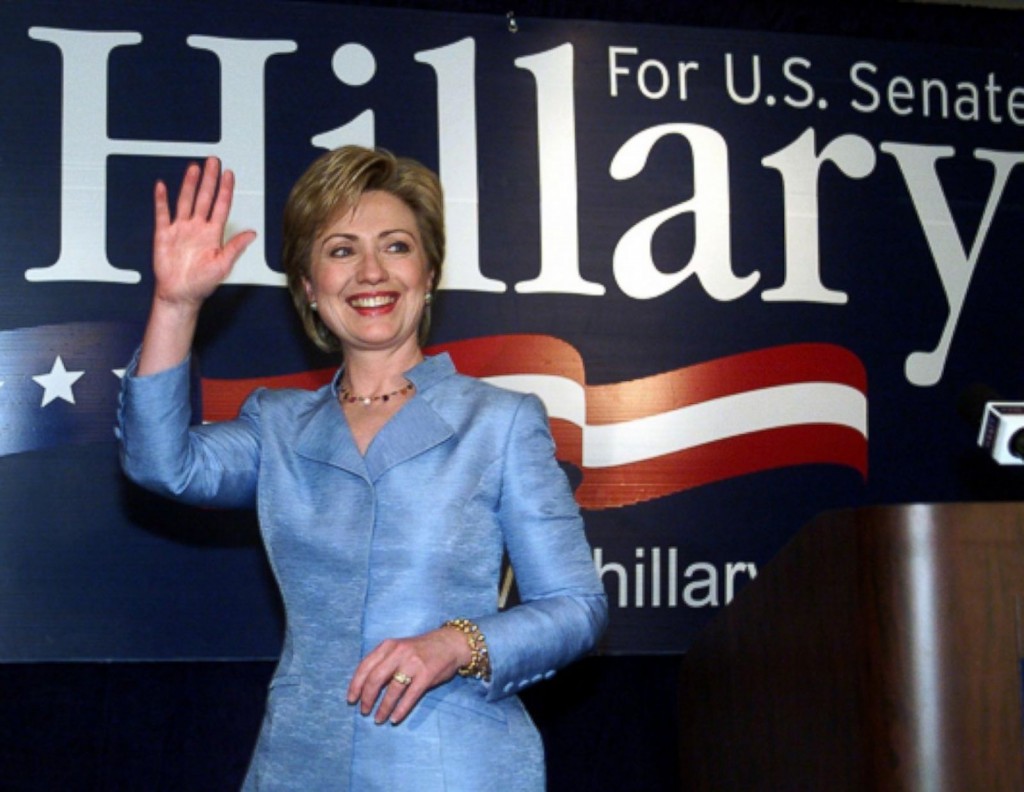
Hillary Clinton waves to reporters as she leaves a news conference in New York, Nov. 8, 2000. Clinton defeated Republican congressman Rick Lazio to win the U.S. Senate seat for New York becoming the first first lady elected to public office. (Photo credit: Doug Kanter / AFP / Getty Images)
By Jennifer Jo Hagel and Aubrey Immelman
St. Cloud Times
December 5, 1999
Recently, Gail Sheehy’s unauthorized biography, Hillary’s Choice (Random House), hit the bookstores. It created something of a media stir on NBC’s “Dateline” and the cable television talk-show circuit.
In her book, the writer for Vanity Fair reveals that the first lady may have “inhaled” in days gone by, and that a 1960s boyfriend described Hillary as “passionate” and himself as “150 pounds of pulsing hormones.”
So, what else is new? Sex, drugs, and — what the heck — rock ‘n’ roll have become emblematic of the muck-raking, sensationalistic, “gotcha” pop-psychological reporting in this era of baby-boomer politics.
Sheehy’s book offers a smattering of legitimate psychological insights relevant to Hillary Rodham Clinton’s political ambitions and leadership potential as she runs for the open U.S. Senate seat in the state of New York. Some of those include Hillary’s lack of accountability and externalization of blame, her combativeness and tendency to crucify opponents, her toughness and lack of empathy, her persistence in the face of adversity, and her strategic manipulation of Bill Clinton.
But what does systematic, empirical observation reveal about Clinton’s political personality? In a study conducted in 1997 and 1998, we established that Clinton’s personality had a primarily dominant, controlling pattern with distinctly ambitious, highly confident features. She also had strong, though secondary, conscientious qualities.
What this means, in practical terms, is the following:
Dominant individuals, in the words of personality theorist Theodore Millon, enjoy the power to direct others and to command compliance and respect. They have an intimidating presence, are tough and unsentimental, and thrive in leadership roles.
Indeed, more than any other personality type, they gain satisfaction in actions that dictate and manipulate the lives of others.
According to Millon, many of these personalities succeed in sublimating their power-oriented tendencies in publicly approved roles and vocations (beats haranguing one’s friends and intimates), though their aggressive inclinations sometimes become evident in intransigence, stubbornness, and coercive behaviors.
Despite these periodic negative expressions, writes Millon, controlling types typically make effective leaders, being talented in supervising and persuading others to work for the achievement of common goals.
John Oldham and Lois Morris, in The New Personality Self-Portrait, rather breathlessly extol the virtues of this forceful personality pattern: “While others may aspire to leadership, aggressive men and women move instinctively to the helm. They are born to assume command as surely as is the top dog in the pack. Theirs is a strong, forceful personality style, more inherently powerful than any of the others.
“They can undertake huge responsibilities without fear of failure. They wield power with ease. They never back away from a fight. They compete with the supreme confidence of champions. … When put to the service of the greater good, the aggressive personality style can inspire a man or woman to great leadership, especially in times of crisis.”
Next, the hallmark of the ambitious aspect of Clinton’s personality is an unshakable belief in oneself and one’s talents.
According to Millon, these personalities are competitive and self-assured, easily assume positions of leadership, act in a decisive and unwavering manner, and expect others to recognize their special qualities and cater to them.
Of special relevance to Clinton’s bid for the Senate, these individuals often succeed in realizing their ambitions and typically prove to be effective leaders.
However, they do have a potentially fatal flaw: their lack of social reciprocity and their sense of entitlement — an assumption that what they wish for is their due.
Finally, as for the conscientious component of Clinton’s personality, its essence is a principled morality and moral certitude. (It is the latter that can be troublesome in a leader.) These personalities, note Oldham and Morris, are quintessentially “loyal to their families and chosen causes,” epitomize the work ethic, and “won’t rest until the job is done and done right.”
In summary, our profile suggests that Clinton’s major personality strengths as a senator will be her commanding power, her clear-eyed vision and unwavering confidence, and her diligent pursuit of mission. Her major weaknesses likely will be her relative lack of congeniality (or collegiality), her uncompromising assertiveness, and a potential for closed-minded inflexibility.
Venturing further, we speculate that her public role will serve as a conduit for the expression and magnification of pre-existing personality traits, the central feature of which is a forceful, unyielding, power motive.
If elected junior senator from the state of New York next November, the patterns outlined here will be the golden thread running through the tapestry of Clinton’s political motives, legislative endeavors, and personal political style.
Books such as Sheehy’s can be a perfectly good read, informative and entertaining, but they are no substitute for more rigorous analysis of personality in politics.
Unfortunately, in their reluctance to tread this conceptual minefield, academic psychologists have left a void filled by other, less qualified practitioners plying their trade of political psychobiography.
Jennifer Hagel graduated in 1998 from the College of St. Benedict, where Aubrey Immelman is an associate professor of psychology. They presented their study of Hillary Clinton at the 1998 annual scientific meeting of the International Society of Political Psychology, in Montreal, Quebec.
Related studies of 2016 Democratic candidates

A psychological assessment of Democratic presidential contender Bernie Sanders will be conducted if the Vermont senator appears viable as a nominee after Super Tuesday. [April 9, 2016 update: Data collection is currently in progress; preliminary results will be released April 19.]
The Personality Profile of 2016 Democratic Presidential Candidate Bernie Sanders (April 19, 2016)
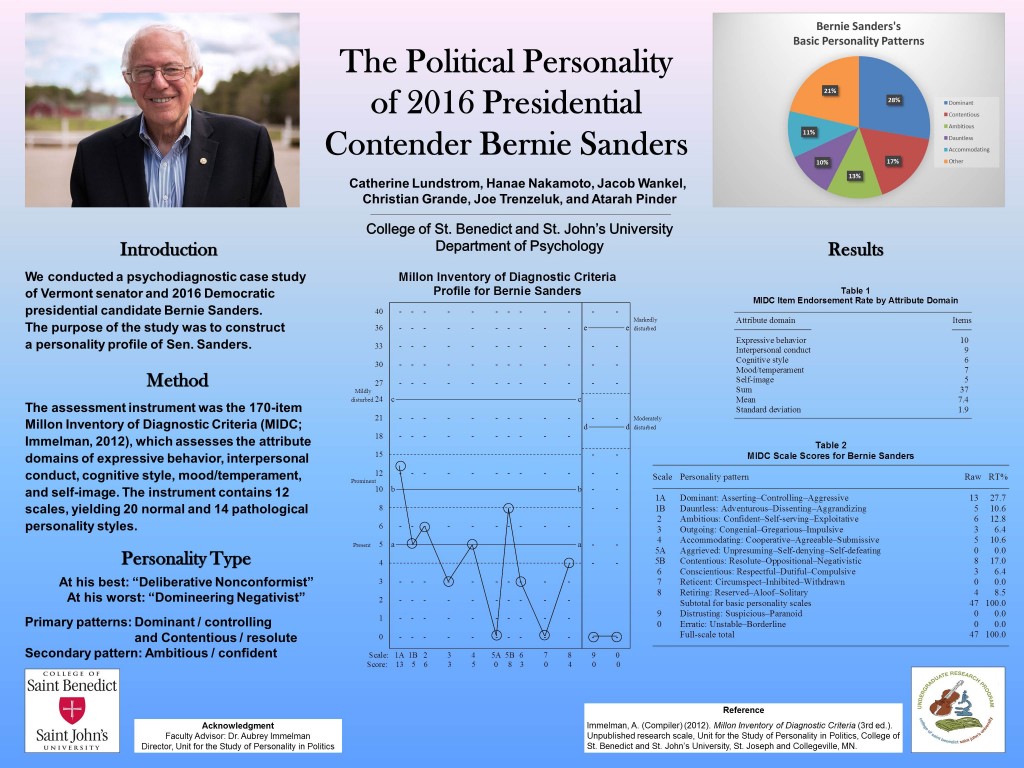
Click on image for larger view
Related reports on this site
Donald Trump’s Narcissism Is Not the Main Issue (Aug. 11, 2016)
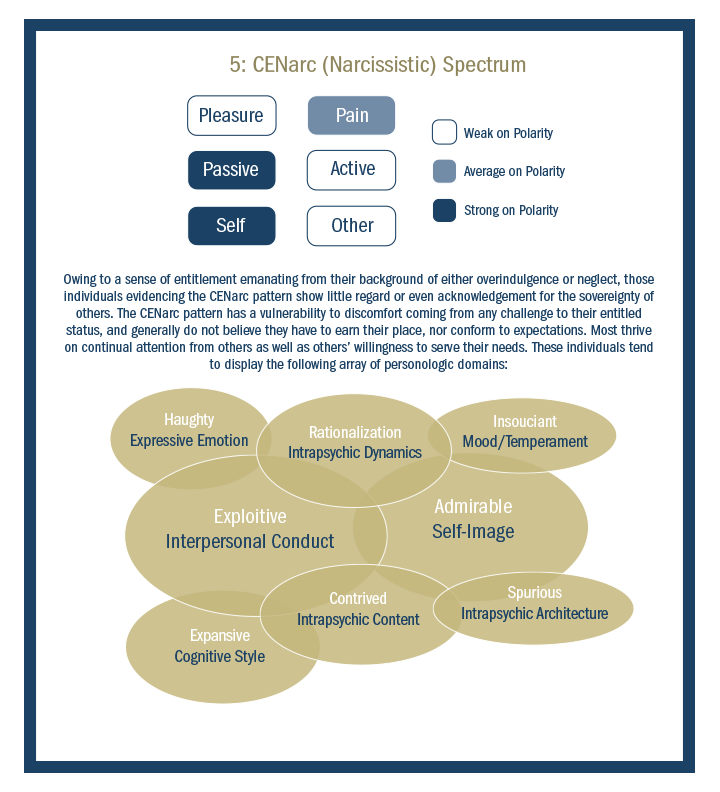
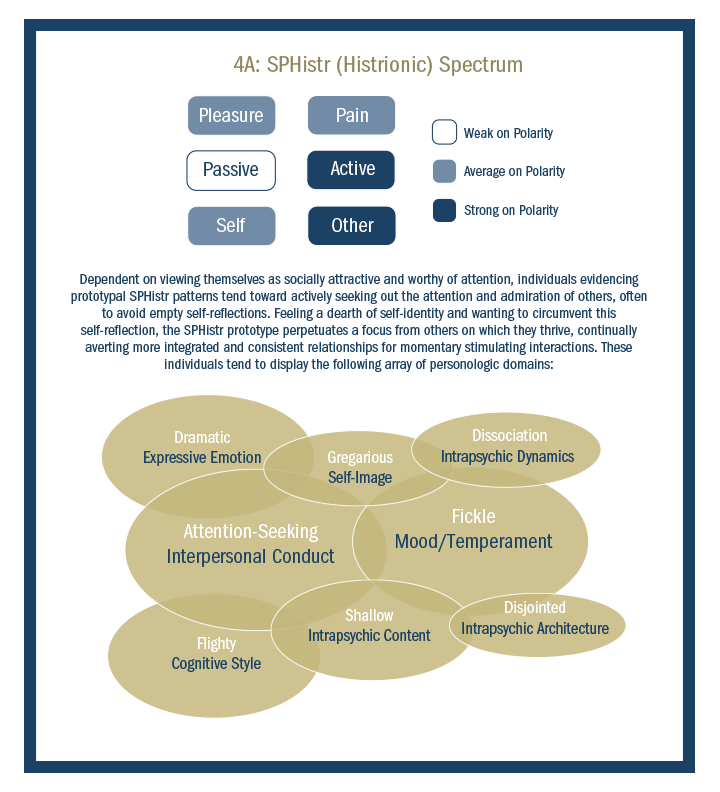
© 2015 MILLON® (Click on images for larger view)
The Personality Profile of 2016 Democratic Presidential Candidate Hillary Clinton (July 27, 2016)
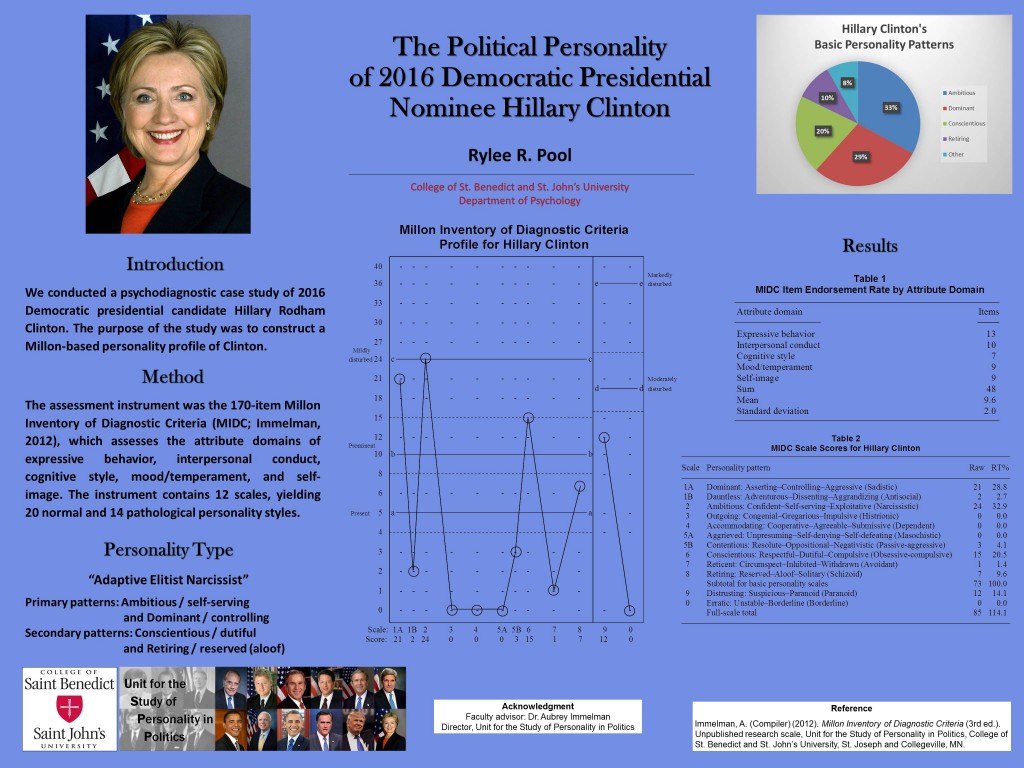
Click on image for larger view
Projecting the Winner of the 2016 Presidential Election: The Personal Electability Index (Feb. 29, 2016)
How Hillary Clinton Stacks Up Against Donald Trump and Jeb Bush: The Personal Electability Index (Aug. 23, 2015)
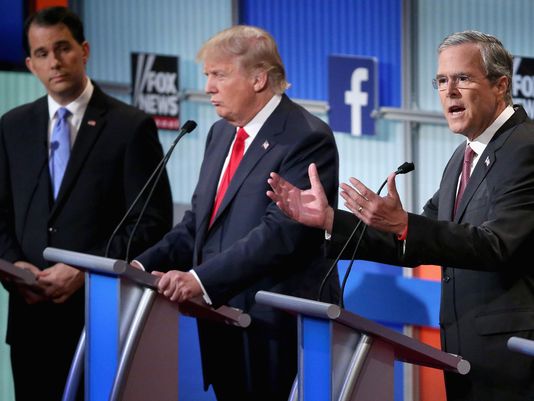
Photo credit: Chip Somodevilla / Getty Images
Comparative Psychological Profiles of GOP Contenders (Aug. 6, 2015)
Psychological Profiles of 2016 Republican Presidential Candidates (April 24, 2015)
Predicting the Outcome of Presidential Elections Before Super Tuesday (May 12, 2011)
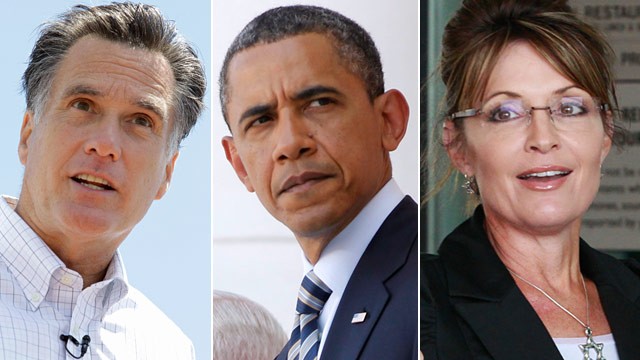
War on Terror Pakistan Blowback (Oct. 30, 2009)
|
Video
|
|
Clinton on tough questions in Pakistan (NBC Nightly News, Oct. 30, 2009) — Secretary of State Hillary Clinton says that she doesn’t think she was too blunt while answering questions during her visit to Pakistan, saying, “It was actually very healthy that there was no false politeness.” NBC’s Andrea Mitchell reports. (02:58)
|
U.S. Warns North Korea on Missiles (Feb. 17, 2009)

U.S. Secretary of State Hillary Clinton speaks at the Asia Society, Feb. 13, 2009 in New York. (Photo: Stephen Chernin / AP)
Media report of political-psychological interest
Secrecy, Sex, Hillary and Bill (Roger Simon, Politico, March 10, 2015) — Secrecy is to Hillary Clinton what sex was to Bill. … In Hillary’s world, everybody is out to get her. Which is why she surrounds herself with ultra-loyalists, people who believe, as she does, that she is entitled to special behavior and special treatment because she is a special victim. … A penchant for control and secrecy. … Full report
Alternate link to “The Personality Profile of 2016 Democratic Presidential Candidate Hillary Clinton” at Unit for the Study of Personality in Politics website » http://Personality-Politics.org/Hillary-Clinton
Leave a Reply
You must be logged in to post a comment.

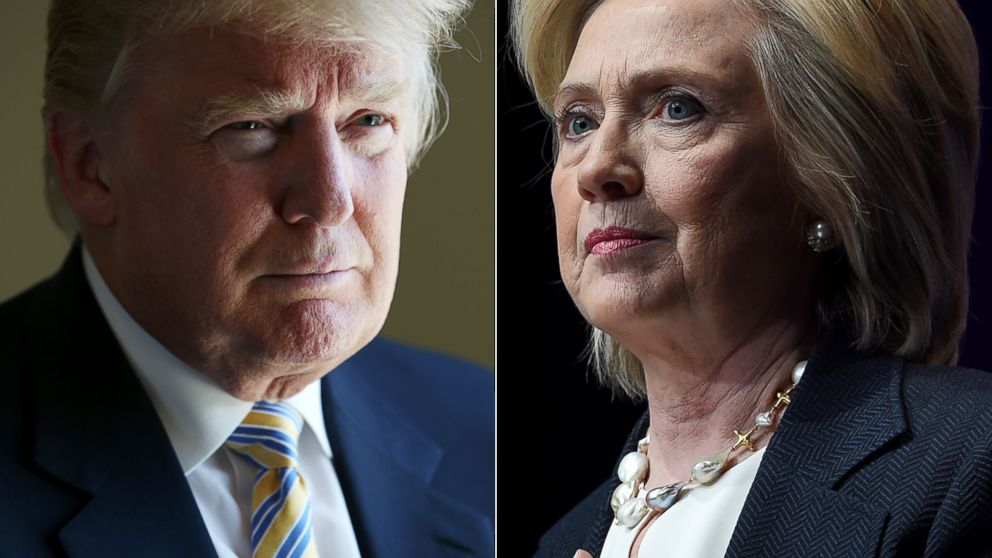
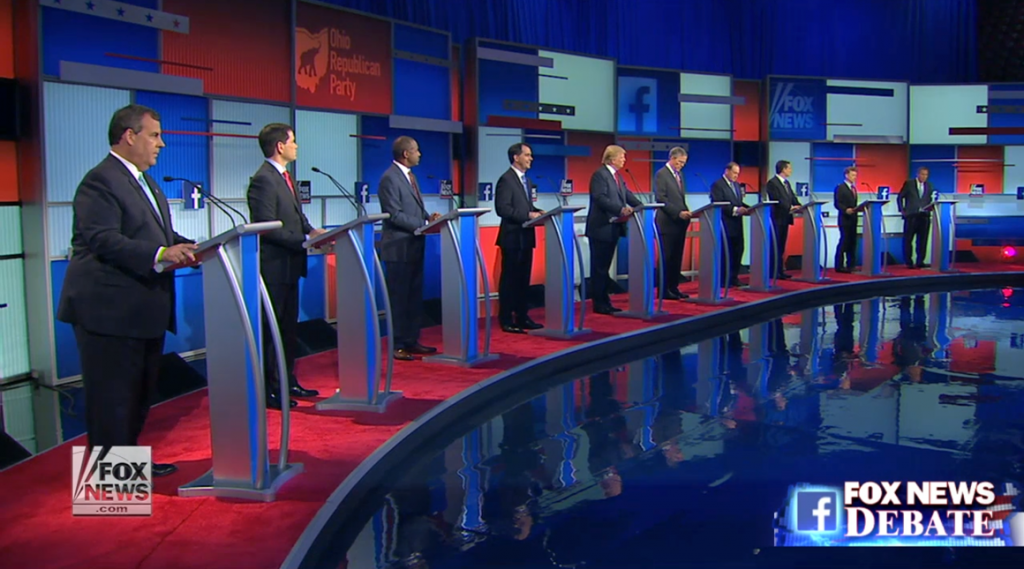
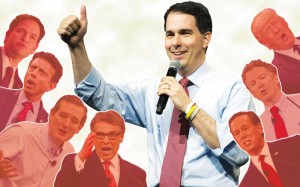


February 29th, 2016 at 8:38 pm
[…] The Personality Profile of 2016 Democratic Presidential Candidate Hillary Clinton (March 11, 2015) […]
April 19th, 2016 at 7:56 am
[…] Behind the Clinton E-mails: The Psychological Profile of Hillary Rodham Clinton […]
April 19th, 2016 at 9:33 am
[…] Behind the Clinton E-mails: The Psychological Profile of Hillary Rodham Clinton […]
July 27th, 2016 at 9:21 am
[…] Behind the Clinton E-mails: The Psychological Profile of Hillary Rodham Clinton […]
September 26th, 2016 at 8:30 am
[…] Behind the Clinton E-mails: The Psychological Profile of Hillary Rodham Clinton […]
November 3rd, 2016 at 12:42 am
[…] Behind the Clinton E-mails: The Psychological Profile of Hillary Rodham Clinton […]